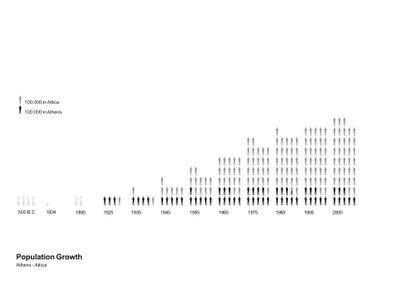The contemporary urban condition can no longer be identified by the dichotomy of city and countryside, inside and outside. Since the 1960s this latent phenomenon of the occupation of the empty space has been described through the term ‘sprawl’. The ambiguity of the term itself and its mostly negative and generalized references bare a hesitance to specifically address and confront this phenomenon architecturally and urbanistically. The overwhelming development of Athens during the last century and its distribution patterns across the Attica landscape have created new spatial qualities and territorial conditions characterized by their own logics and particularities.
From another point of view, central Athens can be considered a ‘Shrinking City’, with its growth offset towards the ‘suburban’ periphery. Due to the dramatic and continuous population increase during the last four decades, Attica ranks amongst the 10 largest urbanized areas in Europe with a population of above 4 million inhabitants such as Madrid, Barcelona, Ruhr Area, Berlin, St. Petersburg or Milan.
 PERIPHERY
PERIPHERYReading and analyzing the Attica conurbation we identify four distinct ‘peripheral’ sites that will form the locus of our investigations. In terms of scale they are identified as:
1. ‘Attica and Beyond’: characterized by the relation of the historic center to the hinterland and by the geographic localities,
2. ‘Outer Peripheries’: including and natural boundaries,
3. ‘Inner Peripheries’: urban islands with the central conurbation; such as Elaionas, Hellenikon, Lykavitos,
4. ‘Peripheral Fragments’: urban set asides, economical and structural left-overs, terrains vagues.
 AMPLIFICATIONS towards the inhabitation of the ‘Negative Space’
AMPLIFICATIONS towards the inhabitation of the ‘Negative Space’Within the context of these peripheral sites and for the purpose of our study, we will adapt the notion of the ‘Negative Space’. We understand the term, as other than physical, open space, green space, agricultural lots or roadside verges but as the space that is not the product of conscious design and planning.
The negative space is understood as the starting point to define and structure the after sprawl condition. Used as a tool for investigation and intervention, in a multiplicity of scales will allow us to structure a new collective space and experience. The reassertion of the negative space will negotiate the ‘evils’ of the built within the context of our contemporary urbanity.
In order to explore, articulate, negotiate, the negative space on different scales, we propose to develop a series of tools or tactics. These will order, amplify, blur existing urban conditions in terms of density, void, scale, verticality, etc. We will delete, abandon and undo, but also add, offset, expand and project.
 References
ReferencesOswalt Philipp, ‘Atlas of Shrinking Cities’, Hatje Cantz Verlag, 2006
Xaveer de Geyter Architects, ‘research for the contemporary city After Sprawl’, NAI Publishers, de Singel, 2002
Oswalt Philipp, ‘Schrumpfende Städte’, Hatje Cantz Verlag, 2004
‘USE Uncertain states of Europe. A trip through a changing Europe’, Skira, 2003
Oswald M. Ungers, Stefan Vieths, ’The Dialectic City’, Skirra editore, 1997
‘Αττικό τοπίο και περιβάλλον’, Υπουργείο Πολιτισμού, Αθήνα,1989
UN World Urbanization Prospects: 2005 Revision, http://esa.un.org/unup/


9 comments:
ειναι πολυ ενδιαφερον το σχεδιαγραμμα με τον πληθυσμο της Αθηνας σε σχεση με τον πληθυσμο της Αττικης, και ποσο δεν εχει αλλαξει το κεντρο. Αραγε ειναι δυνατο ενα αντιστοιχο σχεδιαγραμμα χωρου?
Mou aresei poli auto pou ksekinisate [athens9] alla pistevw pws prepei na allaksete epigontos ti proti selida tou blog. De mou aresei. [ta xromata, ti gramatosira, tin ikona]. Kali sinexia
εννοεις του blog ή του Athens9.net την πρωτη σελιδα?
The four types of peripheries you have identified are very interesting conceptually. Many of the spaces you refer to contain vestiges of other periods, or natural occurrences. In many cases these are agricultural vestiges that look unplanned to the architectural eye but were very much planned at the time. In others they form natural ecosystems which are "unplanned" by humans but are actually functioning mechanisms. In landscape ecological terms these spaces are of great value, and their unexamined erasure is a problem for the city's future. The term "negative space" appears to place a negative value on the said space. We would be very interested in seeing the qualities of the spaces you are dealing with, and their integral relationship with the city in their present state.
andreas, thank you for the comment. We agree, a spatial diagram of ‘shrinking Athens’ will provide better evidence to the argument. We are at present collecting material for drafting one, unfortunately on the basis of very little available information and thus mostly relying on our own observations and recordings.
and Doxiadis +, thank you for your comments. We understand and employ the term ‘negative space’ with positive connotations and intentions. It is the ‘unbuilt’ space with a logic and structure of its own, open to a multitude of interpretations and manipulations. we believe the challenge for us lies in negotiating its scale, context and of course physicality.
and finally. We know that many of the visitors to the ‘athens 9’ are non-Greek speakers. We will keep from now on our ‘project’ postings in English in an attempt to be more inclusive.
Mou aresei poli auto pou ksekinisate [athens9] alla pistevw pws prepei na allaksete epigontos ti proti selida tou ATHENS9.NET. De mou aresei. [ta xromata, ti gramatosira, tin ikona]. Kali sinexia
B+K, Διαφωνω στο να συνεχισετε να ποσταρετε στα αγγλικα (επειδη μαλλον ετσι σας βολευει!!!), και να δειξετε λιγακι σεβασμο στο 95%(αν οχι παραπανω) των αναγνωστων του blog που θεωρω πως ειναι Ελληνες...μιας και το blog αναφερεται εξ ορισμου σε Ελληνικη πολη! Αν κανω λαθος ή συμβαινει το αντιθετο...τοτε συγγνωμη για την συμβουλη μου!
Post a Comment